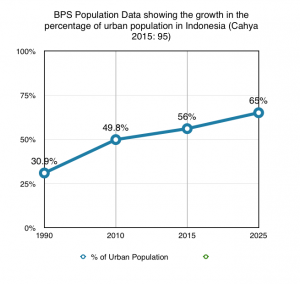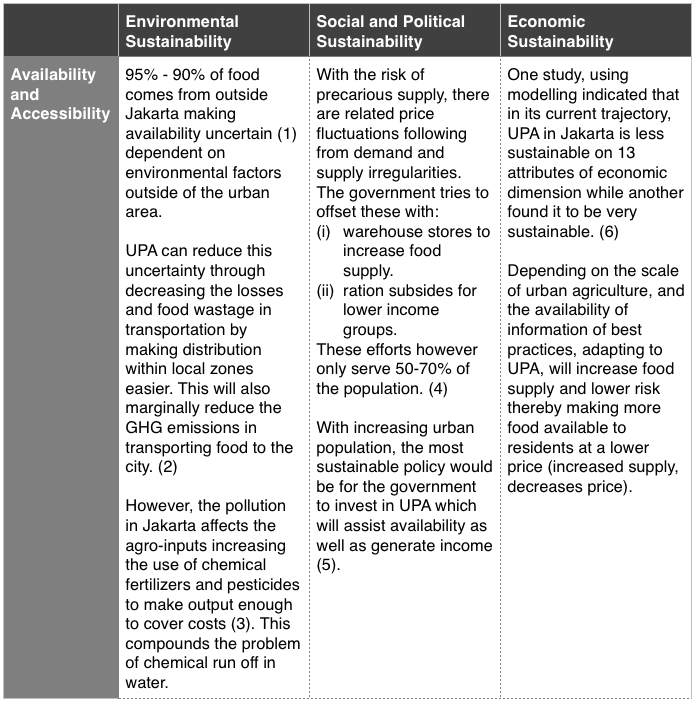Problem: Urban Food Security
- “The high pace of urbanization and population growth in Asian cities has accelerated the increase of food needs, poverty, and environmental degradation” (Pribadi and Paulette 2015).
- For Indonesia, food security is a national challenge (Fiisabiilillah and Maulana, 2016) with Jakarta only covering 4% of its food demand. Combining the high and increasing rates of urban population such as that of Jabodetabek (metropolitan district of Jakarta), ensuring food security within the frame of sustainable long term growth is high priority. To solve this problem, reorganizing the patterns of food production and distribution can be useful. UPA as a tool offers solutions to these problems.

Possible Solution: Urban and Peri-Urban Agricultures (UPA)
The challenge is that UPA has to solve the problem of food security while also meeting the goals of sustainability. While there is evidence for it being a multi-functional solution (DeBon et al., 2010), we will collate and analyze this in a matrix with the context of Jakarta (data is from studies conducted in Jakarta or Jabodetabek).
{The rows indicate the four objectives of food security as determined by the Food and Agricultural Organization (FAO, 2000). The columns are the goals of sustainable urbanization developed by the UN Department for International Development (DFID, 2002). A note of caution: these divisions are purely for organization of thought, not rigid, and more often than not, have spillover effects.}



- Fiisabiilillah 2016
- Benis 2016
- DeBon 2010
- Fiisiibilillah 2016
- Cahya 2016 and DeBon 2010
- Cahya 2016
- DeBon 2010 and Cahya 2016
- Fiisibiilillah 2016
- Fiisibiilillah 2016
Situation: UPA’s Sustainability in Jakarta
UPA has limited use in Jakarta such as in Duri Kosmbi (see Case Study section of the blog) but there is a significant need for its adoption and proliferation in other parts of Jabodetabek. As a tool its costs and benefits are many and require calibration through analysis of multi-dimensional effects. As in Duri Kosmbi, there were positive and negative sustainability factors wherein sustainability was considered holistically. The effects of UPA are not static at one time but inter-temporal. Sustainable strategy requires looking at the growth and expansion of the city alongside the growing trend of UPA, parallel to the changes that UPA and increased urban density will bring. The positive and negative externalities will provide us with the net benefit or cost of adopting the practice on different scales across different times.
Conclusion
Is UPA a solution to the problem of food security?
Yes. Evidence from other parts of the world as well as the small scale example in Duri Kosmbi suggest so (Benis and Ferrao, 2016). Therefore, as a process and contextually, it can work well given adequate institutional support.
Is UPA a sustainable solution?
Maybe. There are dimensions of sustainability that change based on the definition of sustainability. These definitions are important for decision making entities/institutions that determine strategies and policies. A holistic definition has more than just the environment as a dimension. The effects and externalities of UPA thus vary across these dimensions, through time and scale.
The global north, like the global south, faces food security concerns among a variety of urban residents. Lessons from experiments in the global south can be used to ameliorate UPA.
References
Benis, K., & Ferrão, P. (2016). Potential mitigation of the environmental impacts of food systems through urban and peri-urban agriculture (UPA) e a life cycle assessment approach. Journal of Cleaner Production , (140), 784–795.
Bon, H. D., Parrot, L., & Moustier, P. (2010). Sustainable Urban Agriculture in Developing Countries: A Review. Agronomy for Sustainable Development, 21–32. http://doi.org/10.1007/978-90-481-2666-8_38
Cahya, D. L. (2016). Analysis of urban agriculture sustainability in Metropolitan Jakarta (case study: urban agriculture in Duri Kosambi). Procedia – Social and Behavioural Sciences , (227), 95–100.
Fiisabiilillah, D. F., & Maulana, A. (2016). Feeding the Megacity: Challenges to Achieve Food Security in Jakarta. Journal of Regional and City Planning, 27(3), 208–218.
Pribadi, T. (2015). Kelompok fauna rayap pada areal pertanaman kelapa sawit di Katingan, Kalimantan Tengah. http://doi.org/10.13057/psnmbi/m010330